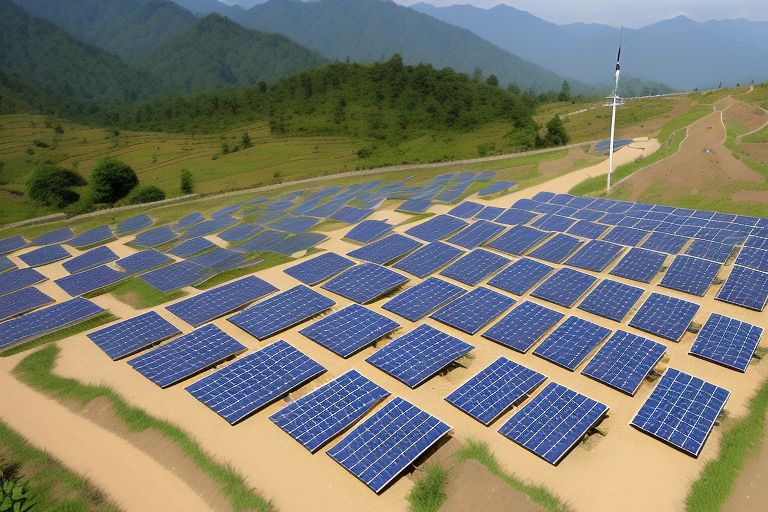The nation is seeing an important increase in renewable energy initiatives while striving to expand its energy options and cut dependence on fossil fuels. Known for its hydropower abilities in the Himalayas country is now aiming its energy plans toward solar and wind as well.
In the last few years,the Nepalese administration has significantly improved its electrical power sector. In the previous five years the country launched 1.100 MW of new hydropower and gathered $1.7 billion in private funding. These actions have established the basis for Nepal’s dream of becoming a leading energy center in the region.
Through its Energy Development Roadmap and Action Plan the government highlights its dedication to renewable energy and aspires to generate 28,700 MW of power by 2035. As part of its strategy to become a high-income nation by 2030 and achieve net-zero emissions by 2045 Nepal has set this ambitious goal.
The core of Nepal’s renewable energy plan is hydropower power. In a country rich in over 6.000 rivers and rivulets lies an estimated potential for hydroelectric energy exceeding 40.000 MW. At present 2.800 MW of hydropower is generated in Nepal and they plan to rise to 15.000 MW by 2030 and 30.000 MW by 2035.
Many large-scale hydropower schemes are planned in the future focusing on projects like the 144 MW Kaligandaki “A” Hydroelectric Project and the Tanahu Hydro Power Project the largest of its kind. The Upper Arun and Dudh Koshi hydroelectric projects will enhance Nepal’s energy supply during the dry months.
The landscape for renewable energy in Nepal is shifting as it diverse its energy mix even though hydropower leads the way. Interest in solar energy is growing. Nepal and the World Bank entered into an alliance for funding $130 million to create a 25 MW solar project linked to the national power system last year. This represents the highest capacity renewable energy project scheduled for the country at present.
The commitment to solar energy by the government is evidence through its association with the Alternative Energy Promotion Centre (AEPC). When AEPC began nearly 10 years ago they focused on about 1 000 solar panels spread across individual dwellings. Now they install more than 100 000 systems per year. The swift increase in solar use aids remote areas in gaining electricity and lowers the nation’s carbon output.
Despite its early stage in Nepal’s development wind power is gaining traction. In the last twenty years the nation created approximately 20 KW with wind energy technologies and shows promise for more advancement.
The Central Renewable Energy Fund (CREF) was created by the Nepalese government for enhancing the development of renewable energy. For businesses looking to invest in renewable technology this fund allows banks access to critical loans. NPR 5 billion (approximately $50 million) will be invested by the government in this program with various contributors making additional contributions to the fund.
By entering a deal with private producers to acquire electricity from renewable resources at agreed rates NEA took an important action. Officials expect this decision to boost investment from the private sector in renewable energy and to enhance Nepal’s onset toward clean energy.
Nepal’s push for renewable energy relies heavily on partnerships formed with global entities. By fostering the growth of clean energy systems for transmission and generation the ADB acts as a crucial partner. The investments from ADB have helped raise electricity access to 98% of Nepalese households through grid and off-grid systems.
The fascination with renewable energy is increasing across a wider scope than traditional energy forms. The country is examining avenues for producing green hydrogen. Due to its rich hydroelectric sources the country can effectively harness clean energy for hydrogen production. During peak demand or low water flow periods green hydrogen could act as a storage option for excess electricity from high hydropower output.
International interest in green hydrogen has grown due to news that an Indian investor plans to invest Rs 2 trillion for green hydrogen production in Nepal provided there is a supportive policy framework.
Although progress is made and potential exists Nepal still confronts several challenges during its renewable energy efforts. To maximize the energy supply generation increases demand for the expansion of power evacuation capabilities. To encourage private investment in renewable energy assets clear directions and rewards are essential.
To overcome these challenges the government implements different initiatives. USAID invests $18.7 million for a five-year project called Urja Nepal to support energy sector growth and reach development targets. The program focuses on three key areas: planning for energy distribution and promoting electric car use will be emphasized.
This initiative involves USAID educating the Nepal Electricity Authority on employing modern power modeling systems to optimize planning and build infrastructure. The program intends to establish charging stations for electric vehicles in the Kathmandu Valley and build an environment for efficient energy use.
The advancement in renewable energy in Nepal serves both national needs and provides new export chances. The government launched selling surplus electricity on the Indian marketplace and plans to increase deals in South Asia. The country may lead in the production and application of clean energy technologies across the region.
The move to renewable energy positively affect Nepals economic growth and surrounding ecosystem. Many people in cities and villages now can start small businesses due to the broad access to clean energy. Additionally the growth in clean energy availability has solved the issues with deforestation faced by the country during the 1970s and 1980s.


